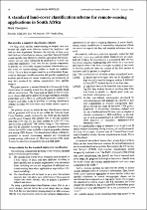 ResearchSpace
ResearchSpace
Standard land-cover classification scheme for remote-sensing applications in South Africa
JavaScript is disabled for your browser. Some features of this site may not work without it.
- ResearchSpace
- →
- Research Publications/Outputs
- →
- Journal Articles
- →
- View Item
| dc.contributor.author |
Thompson, M

|
en_US |
| dc.date.accessioned | 2007-03-14T08:38:24Z | en_US |
| dc.date.accessioned | 2007-06-07T10:05:19Z | |
| dc.date.available | 2007-03-14T08:38:24Z | en_US |
| dc.date.available | 2007-06-07T10:05:19Z | |
| dc.date.issued | 1996-01 | en_US |
| dc.identifier.citation | Thompson, M. 1996. Standard land-cover classification scheme for remote-sensing applications in South Africa. South African Journal of Science, vol. 92(1), pp 34-42 | en_US |
| dc.identifier.issn | 0038-2353 | en_US |
| dc.identifier.uri | http://hdl.handle.net/10204/1924 | en_US |
| dc.identifier.uri | http://hdl.handle.net/10204/1924 | |
| dc.description.abstract | For large areas, satellite remote-sensing techniques have now become the single most effective method for land-cover and land-use data acquisition. However, the majority of land-cover (and land-use) classification schemes used have been developed around specific user objectives (namely, agriculture and conservation), and are often influenced by geographical location and actual data capabilities. Thus very few are directly comparable. At present, no universally accepted standard classification system exists for remote-sensing studies in South (or southern) Africa. There is thus an urgent need for a predetermined framework for land-type classifications that will provide standardized, baseline specifications to ensure consistency and conformity in map data produced by various organizations from satellite imagery. This paper presents a standard hierarchical framework for the classification of remotely sensed data, designed to suit the South African environment. The framework is based on known land cover classes that can be derived from high-resolution, remotely sensed data such as SPOT or LANDSAT Thematic Mapper (TM) imagery, and links, as far as possible, to existing classification systems or codes that have been used within various organizations. | en_US |
| dc.format.extent | 910518 bytes | en_US |
| dc.format.mimetype | application/pdf | en_US |
| dc.language.iso | en | en_US |
| dc.publisher | Bureau Scientific Publications | en_US |
| dc.rights | Copyright: 1996 Bureau Scientific Publications | en_US |
| dc.subject | Land classification | en_US |
| dc.subject | Remote sensing | en_US |
| dc.subject | South Africa | en_US |
| dc.title | Standard land-cover classification scheme for remote-sensing applications in South Africa | en_US |
| dc.type | Article | en_US |
| dc.identifier.apacitation | Thompson, M. (1996). Standard land-cover classification scheme for remote-sensing applications in South Africa. http://hdl.handle.net/10204/1924 | en_ZA |
| dc.identifier.chicagocitation | Thompson, M "Standard land-cover classification scheme for remote-sensing applications in South Africa." (1996) http://hdl.handle.net/10204/1924 | en_ZA |
| dc.identifier.vancouvercitation | Thompson M. Standard land-cover classification scheme for remote-sensing applications in South Africa. 1996; http://hdl.handle.net/10204/1924. | en_ZA |
| dc.identifier.ris | TY - Article AU - Thompson, M AB - For large areas, satellite remote-sensing techniques have now become the single most effective method for land-cover and land-use data acquisition. However, the majority of land-cover (and land-use) classification schemes used have been developed around specific user objectives (namely, agriculture and conservation), and are often influenced by geographical location and actual data capabilities. Thus very few are directly comparable. At present, no universally accepted standard classification system exists for remote-sensing studies in South (or southern) Africa. There is thus an urgent need for a predetermined framework for land-type classifications that will provide standardized, baseline specifications to ensure consistency and conformity in map data produced by various organizations from satellite imagery. This paper presents a standard hierarchical framework for the classification of remotely sensed data, designed to suit the South African environment. The framework is based on known land cover classes that can be derived from high-resolution, remotely sensed data such as SPOT or LANDSAT Thematic Mapper (TM) imagery, and links, as far as possible, to existing classification systems or codes that have been used within various organizations. DA - 1996-01 DB - ResearchSpace DP - CSIR KW - Land classification KW - Remote sensing KW - South Africa LK - https://researchspace.csir.co.za PY - 1996 SM - 0038-2353 T1 - Standard land-cover classification scheme for remote-sensing applications in South Africa TI - Standard land-cover classification scheme for remote-sensing applications in South Africa UR - http://hdl.handle.net/10204/1924 ER - | en_ZA |





